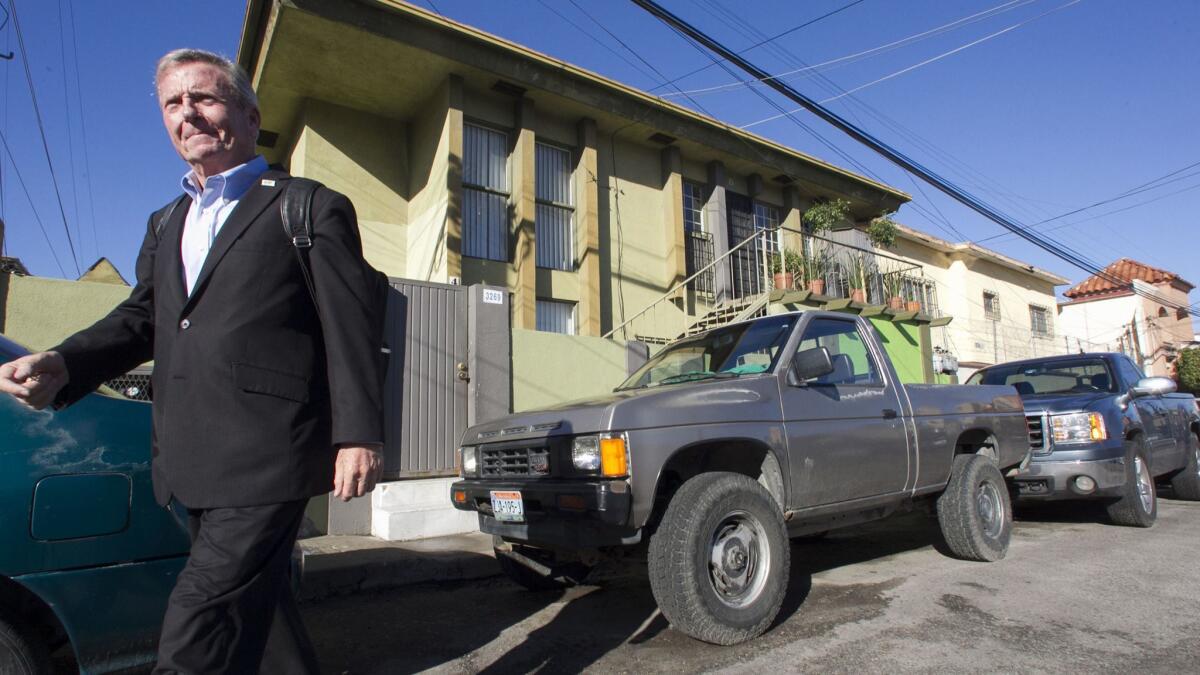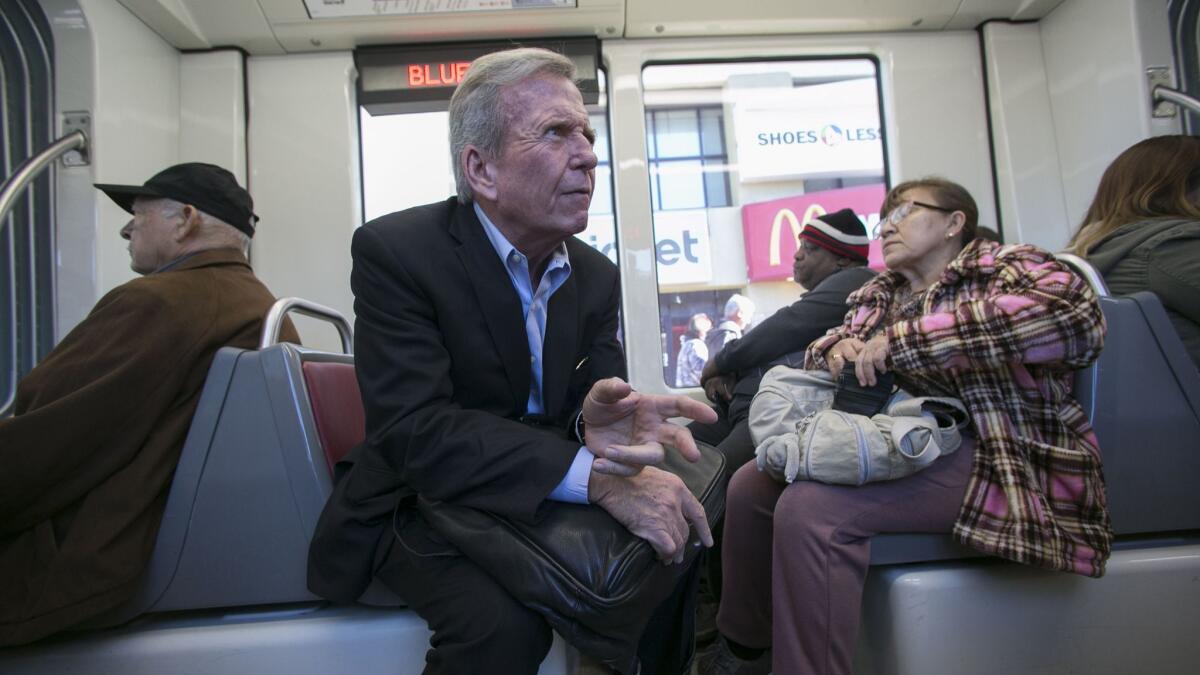Could you deal with a commute from Tijuana every day?

- Share via
It’s 9:30 a.m. Friday in the Mexican city of Tijuana and Bob Morris is walking out of his two-story green apartment complex to begin his commute to the United States.
The 66-year-old American, wearing a black suit, blue shirt, Nike sneakers and a small backpack, hops over puddles from the previous night’s rain and into a Nissan Versa driven by a friend.
His journey to work in San Diego — involving a car, trolley, bus and an international checkpoint — takes an hour and 15 minutes. When the U.S. Customs and Border Protection closed multiple lanes in mid-November to prepare for the migrant caravan, it took him three hours.
Morris is one of many Americans who have made Baja California home and go to jobs nearly daily in San Diego. It has been a trying time for commuters with the migrant caravan causing delays and President Donald Trump even threatening to close the border. While some have accepted the longer commute times, others are rethinking if the daily journey is sustainable.
An exact number of how many Americans are living in Tijuana is hard to come by. Unlike large expat communities farther down the coast, such as Rosarito Beach, Americans in Tijuana are more spread out and harder to find.
While the cost of living is substantially less in Tijuana, it has plenty of unforeseen hurdles. Morris said if everything is perfect, he can get to work in one hour.
Morris’ commute typically involves getting dropped off by car at the border by his friend Luis Torres, who is allowed to use Morris’ car every day in Tijuana as long as he keeps it filled up with gas, and picks and drops him off. He then walks to the PedEast crossing where he goes through the CBP checkpoint into the United States and gets on the San Diego Trolley.
He rides the trolley to San Diego City College where he grabs the bus to Balboa Park for the final leg of his journey.
Morris, born in Orange County, decided four months ago to move to the border city after years of doing work there as a business consultant. He had a few reasons: A desire to learn Spanish better, do a trial run to see if he could retire there and to immerse himself in a different culture.
“I’m really happy I did it. I feel like a richer person because of my experiences on both sides of the border,” he said. “It’s rare that you have the opportunity to live in another country but work in your home country on a daily basis.”
Unlike many commuters who brave the border by car, Morris takes the pedestrian route. It involves a lot more walking, but can be quicker. He is still in the process of applying for an expedited SENTRI (Secure Electronic Network for Travelers Rapid Inspection) pass that allows for quicker passage by car — although it can depend on the day if a car is faster than walking.
Morris did not want to say exactly what his rent was, but that it was likely about a quarter of what he would pay in San Diego — especially for how much he gets. His two-bedroom apartment has a balcony with a view of the two towers of the Grand Hotel Tijuana. But, there are other cost savings, too.
“I can go to a first-run movie in English in a really nice theater for $3.50,” he said. “There’s all sort of financial benefits, like getting your shoes resoled for $20 instead of $60.”
When he moved to the city, he admitted his children were concerned about his safety. But, he said he keeps a low profile and is in a safe neighborhood, near the up-and-coming Colonia Cacho district. “I think in any city, there are places you shouldn’t go,” he said.
A difference in culture
For Americans with family on both sides of the border, it’s not uncommon to live in Tijuana and work in San Diego.
Erik Ocaranza, 43, tried to make living in San Diego for many years but eventually moved to Tijuana three years ago. He was born in San Diego and grew up living on both sides of the border.
For seven years he lived in the Otay Ranch area of Chula Vista, renting a large house with his wife and two children for around $2,800 a month. But, he said his wife who grew up in Tijuana, felt disconnected from other people.
“She missed being close to family, the traditions, the way of living,” he said.
Ocaranza said where he lives now is a quick walk to be with friends or a store, unlike when he lived in San Diego, where he felt like he had to drive everywhere. An added benefit was the cost savings. He now rents a three-bedroom home for $1,400 a month.
His commute is typically fairly easy, given that he has a SENTRI pass, which must be approved by CBP. He said the best case usually involves him crossing the border around 7:55 a.m. and getting to his job as a graphic designer near downtown San Diego by 9 a.m.
But, that all changed when the migrant crisis shut down the San Ysidro Port of Entry. Ocaranza said his boss was understanding, but made it clear that he needed to find a way to get to work on time.
While the family is happy in Tijuana, Ocaranza said he is now considering renting a room for a few days during the week in San Diego or moving the entire family across the border.
To say the least, he’s a bit frustrated with the migrant caravan, believing many were told lies about being able to get into the United States.
Trying to leave Tijuana
Norman Alvarez, 46, commutes from Tijuana every day to his job in Mission Valley as a civil engineer but has his eye set on homeownership in the United States.
He became a naturalized U.S. citizen in 2005 but it was only four years later that he found himself living in his native Mexico again to save money. Alvarez now leaves around 4 a.m. to make it to his job in San Diego by 6 a.m., but said the commute is wearing on him.
“My time that has been on the freeway and traffic, I prefer that to be with my family,” he said.
Alvarez rents a small 1,184-square-foot three-bedroom house near the Estadio Caliente stadium where the Club Tijuana soccer team plays for $675 a month. Before he left for Tijuana, he was paying a $1,500 a month mortgage on a townhouse in San Diego with his ex-wife. Now remarried, he lives with his wife and son in Mexico.
His dream is to buy a townhouse in Chula Vista or San Diego, in part because of his concern over crime in Tijuana, even though he is third generation in the city. Alvarez said he loves the diversity of Tijuana, particularly the Russian, Canadian, Venezuelan immigrants and, recently, Haitian refugees who have begun integrating into the city. But, the migrant caravan closing the border partially contributed to his decision to leave.
“I wasn’t happy,” Alvarez said. “It affected a lot of people I know. It was a lot of headaches.”

By the numbers
The most enthusiastic Tijuana promoters insist there are plenty of Americans living in the city, but how many are we really talking about?
The U.S. State Department says that more than 1 million U.S. citizens live in Mexico but it does not keep track of what city or even which region. San Ysidro is the busiest border crossing in the Western Hemisphere with roughly 70,000 vehicles and 25,000 pedestrians moving between the two nations each day.
About a third of those arriving by car and on foot are coming to jobs in San Diego, said an estimate from the San Diego Regional Chamber of Commerce. Even if each person crossing is asked if they are going to work and where they are from, no one is logging it into a database for economic analysis.
Yet keeping track of just how many San Diego workers are commuting from Tijuana could be come more important in the coming years, provided the border commute stays roughly the same as it is now. President Trump has threatened to permanently close the southern border if Congress does not approve funding for a border wall, but most experts say it would be nearly impossible to do.
Seth Kaplowitz, a finance lecturer at San Diego State University, said he thinks more San Diegans will be moving to Tijuana in the future as housing costs escalate. Also, he said if a recession hits in the next few years, it could be a viable option for San Diegans who need a cheaper place to live.
“There (are) so many people from San Diego that have a place in Mexico, I don’t see (more people moving there) as being far-fetched at all,” he said. “You can get a lot for your dollar down there.”
Kaplowitz said as a teacher who doesn’t make much money, he would be a good candidate for moving to Tijuana. He said a lot of his students come from Tijuana, something he admires because of the effort it takes just to get an education.
If Americans did decide to live in Tijuana, there are substantial cost savings in terms of housing. A firm average rent in Tijuana is hard to come by, but a San Diego Union-Tribune analysis of online postings found the average rent to be around $500 a month for a one-bedroom unit, varying wildly depending on neighborhood.
For instance, a new complex that opened in 2016 called Aguascalientes 3917, has two-bedroom apartments that start at $1,000 a month. Another new complex that opened in 2018, called Eazy Living, charges $799 a month for a one-bedroom and $1,049 for a two-bedroom. Both complexes are in areas of Tijuana with more new construction and near the city’s Central Zone.
No matter how you cut it, housing is cheaper than its neighbor to the north. The average rent in San Diego County hit an all-time high of $1,960 a month in September, said local real estate tracker MarketPointe Realty Advisors.
Business
phillip.molnar@sduniontribune.com (619) 293-1891 Twitter: @phillipmolnar
ALSO
San Diego’s new single-family homes are pricey, modern and in short supply
Tijuana condo craze continues in to 2018
Last year’s housing market broke records
More to Read
Sign up for Essential California
The most important California stories and recommendations in your inbox every morning.
You may occasionally receive promotional content from the Los Angeles Times.







